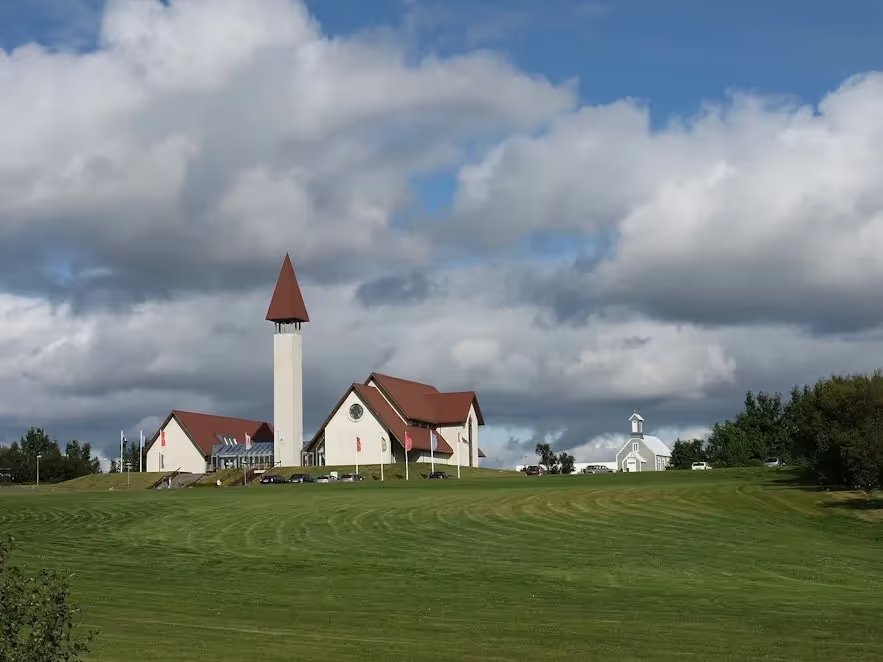
Reykholt, located in West Iceland’s Borgarfjörður region, holds a unique place in Icelandic history. It was once the home of the 13th-century poet and politician Snorri Sturluson, whose contributions to Icelandic literature and governance shaped the medieval period.
Snorri authored pivotal works such as Heimskringla and Snorra Edda, which remain vital sources for understanding Norse mythology and the history of Scandinavian royalty. Reykholt became a hub of intellectual activity during his time, attracting scholars and leaders alike.
Among the most fascinating landmarks in Reykholt is Snorralaug, a geothermal pool that was believed to have been used by Snorri. The site, which still stands today, reflects the sophisticated use of geothermal energy in the Middle Ages.
Visitors can also explore the remnants of Snorri’s farm and a tunnel that once connected his house to the pool. The Snorrastofa Cultural and Research Centre further enriches this historic site, which offers exhibitions on Snorri’s life and the broader context of medieval Iceland.
Reykholt’s surroundings are equally impressive, with natural wonders such as Hraunfossar and Barnafoss waterfalls nearby and Deildartunguhver, one of Europe’s most powerful hot springs. This blend of cultural heritage and striking natural beauty makes Reykholt a remarkable destination for those seeking to experience history and nature at their finest.
Reykholt, located in West Iceland’s Borgarfjörður region, holds a unique place in Icelandic history. It was once the home of the 13th-century poet and politician Snorri Sturluson, whose contributions to Icelandic literature and governance shaped the medieval period.
Snorri authored pivotal works such as Heimskringla and Snorra Edda, which remain vital sources for understanding Norse mythology and the history of Scandinavian royalty. Reykholt became a hub of intellectual activity during his time, attracting scholars and leaders alike.
Among the most fascinating landmarks in Reykholt is Snorralaug, a geothermal pool that was believed to have been used by Snorri. The site, which still stands today, reflects the sophisticated use of geothermal energy in the Middle Ages.
Visitors can also explore the remnants of Snorri’s farm and a tunnel that once connected his house to the pool. The Snorrastofa Cultural and Research Centre further enriches this historic site, which offers exhibitions on Snorri’s life and the broader context of medieval Iceland.
Reykholt’s surroundings are equally impressive, with natural wonders such as Hraunfossar and Barnafoss waterfalls nearby and Deildartunguhver, one of Europe’s most powerful hot springs. This blend of cultural heritage and striking natural beauty makes Reykholt a remarkable destination for those seeking to experience history and nature at their finest.
Reykholt is renowned as the home of Snorri Sturluson, a 13th-century scholar, poet, and politician who pivotally preserved Old Norse mythology and the history of Norwegian kings. His works, such as Snorra Edda and Heimskringla, are invaluable to scholars today. The village was also a significant intellectual hub in medieval Iceland.
Yes, visitors can explore the remains of Snorri’s farm in Reykholt, including a tunnel that connected his house to the medieval geothermal pool, Snorralaug. The Snorrastofa Cultural and Research Centre offers exhibitions and guided tours about his life and the area's rich history.
Nearby attractions include the stunning Hraunfossar and Barnafoss waterfalls and Deildartunguhver, Europe’s highest-flowing hot spring. These natural landmarks offer visitors a blend of historical and scenic experiences.
Reykholt is approximately a one-hour and twenty-minute drive (around 101 kilometers) from Reykjavik. Visitors can take Ring Road 1 towards Borgarnes and then follow Road 50 to reach Reykholt.
The ideal time to visit Reykholt is between April and September, when the Snorrastofa Centre operates daily, offering a full range of tours and exhibitions. The weather is also milder, making it easier to explore the surrounding natural attractions.
Why should you?